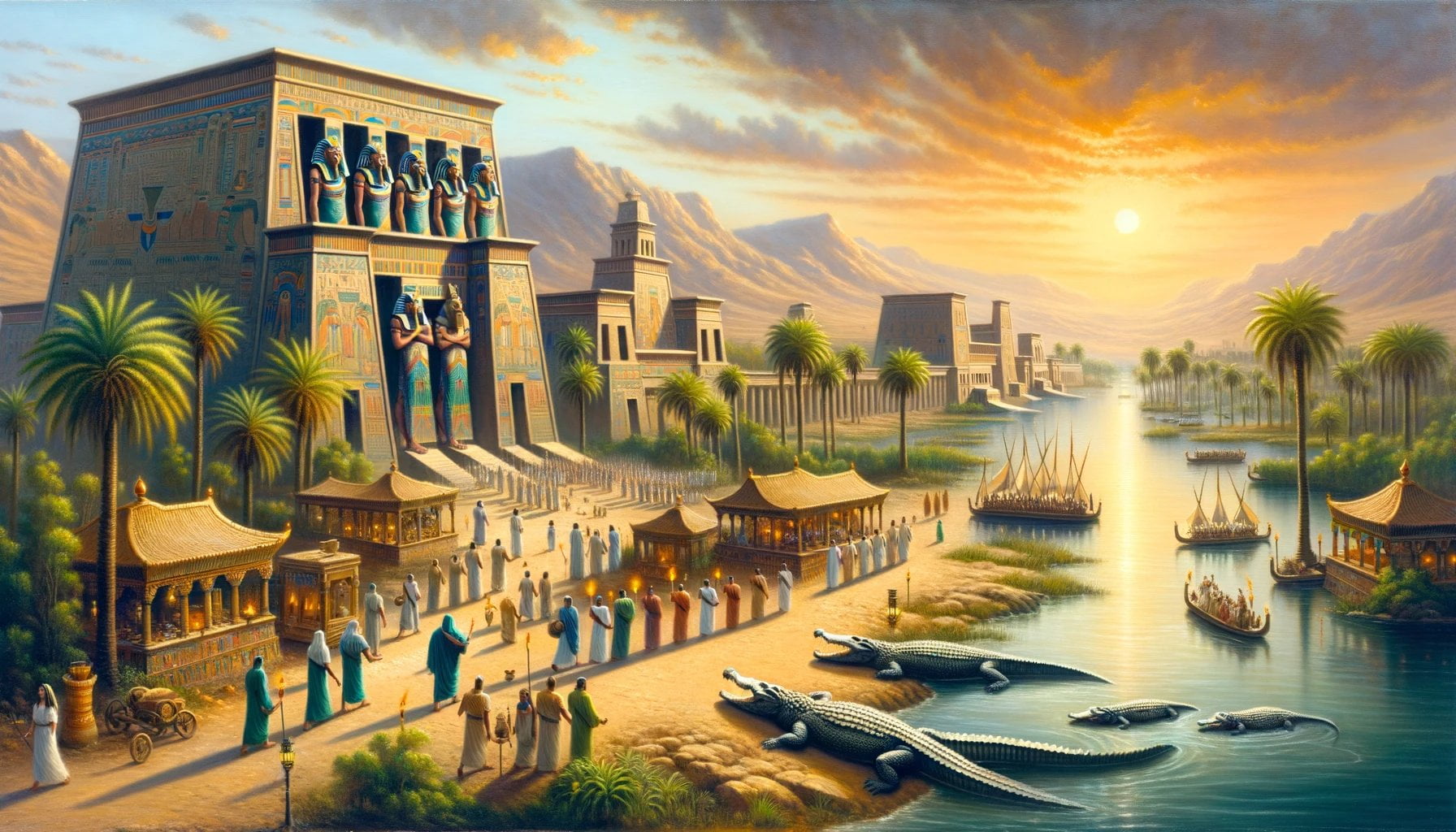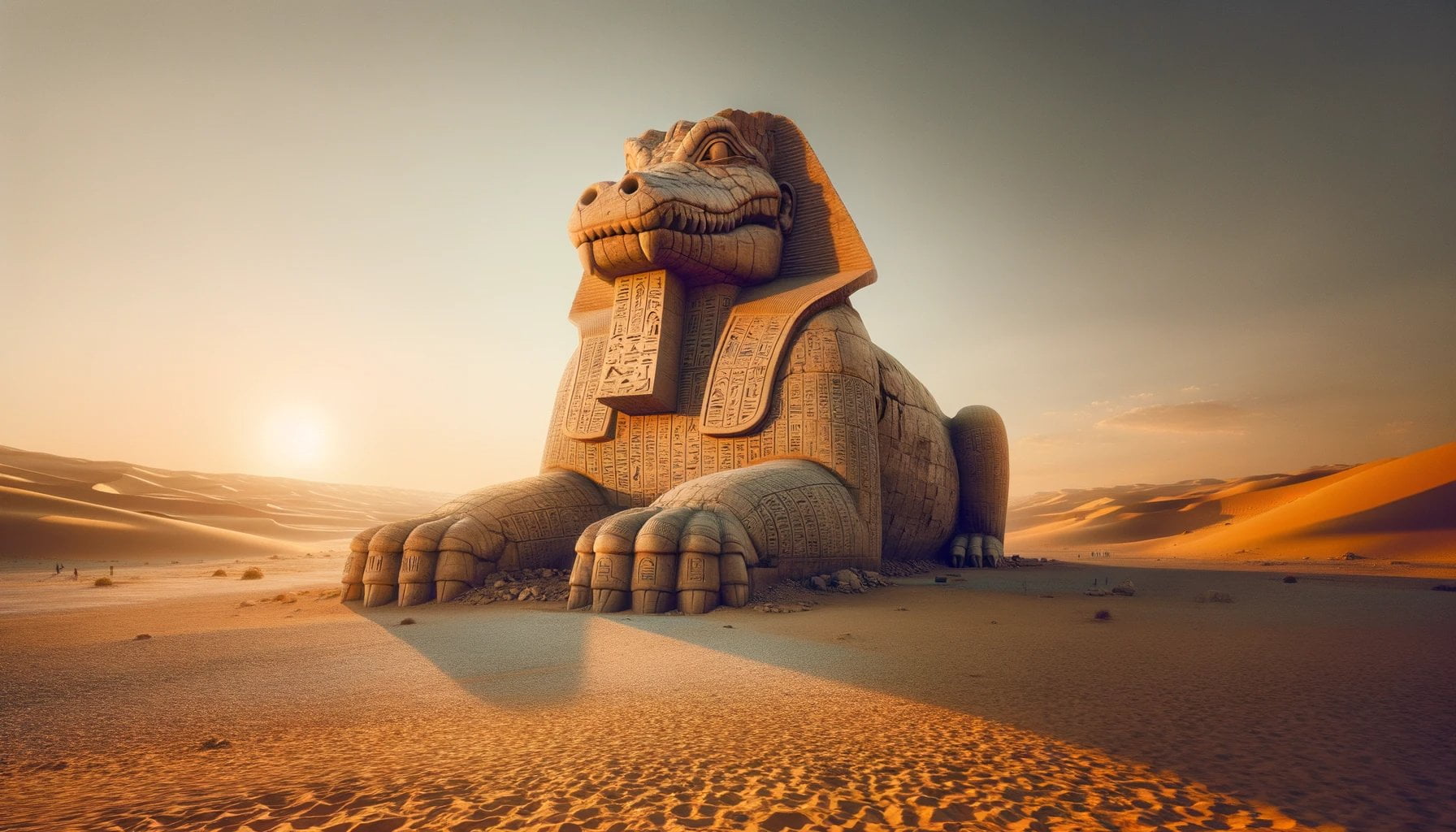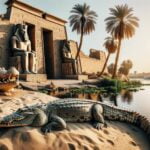Unveiling the Ancient Egyptian Crocodile God: Sobek’s Sacred Role takes us on a captivating journey into the mysterious world of ancient Egypt, where gods and goddesses ruled supreme. This article delves into the intriguing realm of crocodile god worship in ancient Egypt, with a particular focus on the powerful deity, Sobek. Through meticulous research and expert analysis, we unravel the sacred role Sobek played in the ancient Egyptian culture, religion, and symbolism. Join us as we unveil the captivating secrets of Sobek’s divine presence and discover its profound significance within the rich tapestry of ancient Egypt.

Key Takeaways:
- Sobek was an ancient Egyptian deity associated with the Nile crocodile or the West African crocodile.
- He is represented as either a crocodile or a human with a crocodile head.
- Sobek was the Egyptian crocodile god of strength and pharaonic power.
- He served as the protector of the divine pharaoh Osiris and the Egyptian people.
- Sobek was worshiped by the ancient Egyptians and symbolized power, virility, and fertility.
- He was the divine ruler and protector of the Nile River, closely linked to ancient Egyptian civilization.
- Sobek’s origins can be traced back to the city of Faiyum in the Nile Delta region.
- Mummified crocodiles were found in ancient Egyptian temples dedicated to Sobek.
- Sobek was sometimes referred to as the “Lord of Faiyum” and worshiped at the cult center Sheet.
- As a water deity, Sobek was believed to have originated in the Faiyum region.
- Sobek had a complex nature within Egyptian mythology, embodying strength and the power of crocodiles.
- He symbolized strength, power, protection, and royal authority.
- The worship of Sobek peaked during the Greco-Roman period in Egypt.
- Sobek played a significant role in Egyptian military campaigns and protected pharaohs and the Egyptian army.
- Sobek’s strength and courage allowed the pharaoh to overcome obstacles and protected against evil magic.
Unveiling the Ancient Egyptian Crocodile God: Sobek’s Sacred Role
The ancient Egyptians revered a mighty deity known as Sobek, the crocodile god of strength and power. With a fierce and striking presence, Sobek held a significant position within the pantheon of ancient Egyptian gods. Let’s delve into the intriguing world of Sobek, unearthing his sacred role in the mystical land of ancient Egypt.
Sobek: The Powerful Guardian
At first glance, Sobek appears as a formidable half-human, half-crocodile figure. The ancient Egyptians believed that Sobek possessed the strength and courage of a crocodile, characteristics that they deeply admired and revered. Sobek’s association with the Nile crocodile, a creature renowned for its ferocity, further heightened his stature as a god of power and protection.
Did you know? Sobek was often depicted as a crocodile or as a human with the head of a crocodile. This distinctive representation reflected his dual nature as both a god and a fearsome creature.
Sobek and Pharaonic Power
Sobek was intimately linked to the divine pharaoh, serving as their protector and ally. The pharaohs of ancient Egypt were believed to embody the god Osiris, and Sobek played a vital role in safeguarding their authority and well-being. As the Egyptian crocodile god of pharaonic power, Sobek stood as a symbol of strength and royal authority.
In times of war, Sobek’s bravery was invoked to guide the Egyptian army to victory. His divine influence provided protection against danger and ensured the pharaoh’s triumph over adversaries. The people of ancient Egypt saw Sobek as their guardian and relied on his unwavering might to shield them from harm.
Sobek’s Connection to the Nile
The Nile River held immense significance in the life of ancient Egypt, providing sustenance, fertile soil, and transportation. Sobek, as the divine ruler and protector of the Nile, directly influenced the prosperity and well-being of the civilization. The Nile crocodile, an embodiment of Sobek’s power, was a common sight in the river, further strengthening his association with this life-giving waterway.
Did you know? Sobek’s origins can be traced back to the city of Faiyum in the Nile Delta region. This area was a hotspot for crocodile cults and temples dedicated to Sobek’s worship, showcasing the god’s immense popularity among the ancient Egyptians.
The Complex Nature of Sobek
Sobek’s role in ancient Egyptian mythology extended beyond strength and protection. He embodied the complex and elastic nature of the Nile crocodile, representing both its brutal power and the fertility associated with the river’s annual flood. Sobek’s connection to virility and fertility made him a patron of procreation and renewal, highlighting his multifaceted significance within ancient Egyptian society.
Did you know? Temples dedicated to Sobek often housed mummified crocodiles as a form of religious devotion. These sacred creatures were cared for and venerated, reflecting the reverence that the ancient Egyptians held for Sobek and his crocodilian form.
Sobek: Guardian of the Greco-Roman Era
During the Greco-Roman period in ancient Egypt, the worship of Sobek experienced a resurgence, reaching new heights of popularity. The god’s fierce strength resonated with the military campaigns and conquests of the time, earning Sobek a prominent place in the hearts and minds of the people.
Did you know? Sobek’s association with power and protection continued to influence the cultural and religious practices of the ancient Egyptians, transcending the boundaries of time and leaving a lasting legacy on the land of pyramids and pharaohs.
In conclusion, the crocodile god Sobek held an esteemed position in ancient Egyptian mythology. As the protector of pharaohs and the Egyptian people, his strength, power, and connection to the Nile River made him a symbol of authority and prosperity. Through the ages, Sobek’s sacred role has captivated the imaginations of archaeologists, historians, and enthusiasts, shedding light on the rich tapestry of ancient Egyptian beliefs and traditions.
Note: Sources used in crafting this article include Sobek’s Wikipedia page and Egyptian-History.com’s article on Sobek, the Crocodile God.
In ancient Egypt, there were three powerful kingdoms that shaped its history. Curious to know what they were? Find out more about the 3 kingdoms of ancient Egypt here.
Have you ever heard of the ancient city of Kourion in Cyprus? It was a significant cultural and archaeological site. Dive into the wonders of ancient Kourion in Cyprus here.
Ancient Greece was known for its skilled warriors, but do you know what the ancient Greek word for warrior is? Uncover the fascinating ancient Greek word for warrior here.
Want to learn about some famous people from ancient China? Discover the remarkable individuals that left their mark in ancient China here.
Craftsmanship played a vital role in ancient Egypt, but what exactly did craftsmen do? Unveil the secrets of what craftsmen did in ancient Egypt here.
Are you interested in ancient pagan cultures and names? Delve into the enchanting world of ancient pagan names here.
The Significance of Sobek in Egyptian Culture and Religion
Throughout ancient Egyptian history, the crocodile god Sobek held a profound significance in the culture and religion of this ancient civilization. With his association with protection, fertility, and kingship, Sobek’s influence extended far and wide. Let us delve into the world of this fascinating deity and explore his sacred role in Egyptian society.
Sobek’s Origins and Rise to Prominence
Originally a local deity, Sobek’s prominence grew during the Middle Kingdom, impacting both politics and religion (“Sobek’s Legacy in Ancient Egypt”). Known for blending with other deities such as Ra, Horus, and Amun, Sobek’s influence became more widespread and powerful (“Sobek’s Legacy in Ancient Egypt”).
The Powerful God of Protection, Fertility, and Kingship
Sobek was revered as a god of protection, fertility, and kingship (“Sobek’s Legacy in Ancient Egypt”). Through various myths, he played a significant role in the creation of the world, the resurrection of Osiris, and the birth of Horus (“Sobek’s Legacy in Ancient Egypt”). His distinctive depiction as a man with the head of a crocodile symbolized power and virility, embodying the qualities he represented (“Why was Sobek a crocodile?”).
Impact on Egyptian Politics and Religion
During the Middle Kingdom, Sobek’s story had a profound effect on the politics of the time, marking a turning point in his role within the Egyptian pantheon (“The Rise of Sobek in the Middle Kingdom”). King Amenemhat III’s keen interest in Sobek elevated the god’s status and led to his portrayal as a protector of the pharaoh and the people (“Why did ancient Egyptians worship Sobek?”). This gave rise to rituals and sacrifices dedicated to Sobek in various temples across Egypt (“Crocodile God Sobek: The Alluring Legend of Ancient Egypt”).
Worshiping Sobek for Prosperity and Well-being
Ancient Egyptians believed that by worshiping Sobek, they could ensure the fertility of their crops, the success of military campaigns, and the well-being of their pharaohs (“Why did ancient Egyptians worship Sobek?”). Sobek’s worship was especially popular in the Faiyum region, where his veneration centered around Lake Moeris and the city of Crocodilopolis (“Why did ancient Egyptians worship Sobek?”).
The Legacy of Sobek
Sobek’s legacy extends beyond Egyptian borders and continues to captivate the imaginations of archaeologists, historians, and enthusiasts alike. His influence can be seen in various aspects of Egyptian history and beyond, shedding light on ancient Egyptian beliefs and traditions (“Sobek’s Legacy in Ancient Egypt”).
Key Takeaways:
– Sobek, the ancient Egyptian god of protection, fertility, and kingship, played a significant role in the culture and religion of ancient Egypt.
– Originally a local deity, Sobek’s prominence grew during the Middle Kingdom.
– He was often blended with other deities and known for his distinctive depiction as a man with the head of a crocodile.
– Sobek’s story impacted Egyptian politics, marking a turning point in his role within the pantheon.
– Worshipping Sobek was believed to ensure fertility, success in military endeavors, and the well-being of the pharaohs.
– Sobek’s legacy continues to be studied and sheds light on ancient Egyptian beliefs and traditions.
Sources:
1. Ancient Egypt Online – Sobek | The Crocodile God Of Strength And Power
2. Arce.org – The Rise of Sobek in the Middle Kingdom
Depiction and Symbolism of Sobek in Ancient Egyptian Art and Architecture
Ancient Egyptian art and architecture offer a fascinating insight into the depiction and symbolism of Sobek, the crocodile god. Through intricate carvings, sculptures, and temple designs, the ancient Egyptians creatively captured the essence of this powerful deity. Let’s explore the captivating world of Sobek’s representation in ancient Egyptian art and architecture.
Sobek’s Iconic Depiction
In ancient Egyptian art, Sobek was commonly portrayed as a man with the head of a crocodile. This distinctive hybrid form symbolized his dual nature as both a god and a fearsome creature. The detailed craftsmanship of these portrayals highlights the ancient Egyptians’ reverence for Sobek and their artistic prowess.
The combination of human and crocodile characteristics in Sobek’s depictions allowed the ancient Egyptians to visually communicate his power and unique role in Egyptian mythology. The presence of this iconic representation not only served as an artistic portrayal but also reinforced Sobek’s significance in the ancient Egyptian pantheon.
Symbolism in Ancient Egyptian Art
Ancient Egyptian art is renowned for its rich symbolism, and Sobek’s depictions were no exception. The crocodile god represented various nuanced concepts through his imagery.
Firstly, Sobek embodied the strength and virility associated with the Nile crocodile. His depiction as a powerful deity communicated the ancient Egyptians’ fascination with the might and ferocity of these reptiles. This symbolism also extended to the Nile River itself, which was seen as a life-giving force that nurtured fertility and abundance in the land.
Additionally, Sobek’s association with military power and protection is evident in his depictions. The ancient Egyptians believed that invoking Sobek’s bravery would ensure success in military campaigns and safeguard the divine pharaoh’s authority.
Sobek in Ancient Egyptian Architecture
Sobek’s significance extended beyond art and permeated ancient Egyptian architecture. Temples dedicated to Sobek were architectural marvels that highlighted the prominence of his worship in ancient Egyptian culture. These grand structures housed magnificent statues, reliefs, and hieroglyphic inscriptions that depicted the crocodile god and reinforced his sacred role.
In some temples, mummified crocodiles were preserved and venerated as a form of religious devotion to Sobek. These sacred animals were seen as embodiments of the god himself and were carefully interred within the temple complex. The presence of these mummified crocodiles served as a tangible connection between the ancient Egyptians and their revered god.
Key Takeaways:
- Sobek, the crocodile god, was prominently depicted as a man with the head of a crocodile in ancient Egyptian art. This hybrid representation symbolized his dual nature as both a god and a fearsome creature.
- The depiction of Sobek in ancient Egyptian art showcased the ancient Egyptians’ craftsmanship and artistic skills, reflecting their reverence for the deity.
- Sobek’s depictions in ancient Egyptian art carried rich symbolism. They represented his strength, virility, and connection to the Nile crocodile, while also embodying military power and protection.
- Ancient Egyptian architecture incorporated Sobek’s imagery, with grand temples dedicated to the crocodile god. These temples housed statues, reliefs, and hieroglyphic inscriptions that celebrated Sobek’s sacred role in Egyptian culture.
- Mummified crocodiles were preserved and venerated in some of these temples, further emphasizing the close relationship between Sobek and his worshippers.
Sources:
Sobek’s Role in Daily Life and Rituals of Ancient Egyptians
Sobek, the crocodile god of ancient Egypt, played a significant role in the daily life and rituals of the ancient Egyptians. Depicted as a powerful deity with the head of a crocodile, Sobek symbolized strength, power, and virility. His worship was deeply ingrained in Egyptian culture and had a profound impact on various aspects of society.
Importance of Sobek in Ancient Egyptian Culture
Ancient Egyptians had a complex relationship with crocodiles, both fearing and revering them. Sobek represented the powerful and sometimes unpredictable nature of the Nile crocodile. As the god of the Nile and of fertility, Sobek was associated with the prosperity of crops and the life-giving waters of the Nile. His worship was believed to ensure the fertility of the land and the success of military campaigns.
Sobek’s Role as a Protector
Sobek played a crucial role as a protector in ancient Egyptian society. He safeguarded the pharaoh, the divine ruler of Egypt, from harm and evil magic. The ancient Egyptians believed that Sobek’s strength and courage would help the pharaoh overcome obstacles and achieve victory in times of war. Sobek was also seen as a protector of the entire population and the Egyptian army, ensuring their safety and well-being.
Worship Practices and Influence
The worship of Sobek involved various rituals and practices that were central to ancient Egyptian culture. Priests dedicated to Sobek oversaw his worship, which included the mummification of crocodiles and the management of temple sites. These temples, often architectural marvels, housed statues, reliefs, and hieroglyphic inscriptions depicting Sobek and his sacred role.
By venerating Sobek, the ancient Egyptians believed they could ensure the fertility of their crops, the success of their military campaigns, and the well-being of their pharaohs. Sobek’s influence extended to the Faiyum region, where his worship centered around the Lake Moeris and the city of Crocodilopolis.
Key Takeaways:
- Sobek, the crocodile god of ancient Egypt, had a profound influence on the daily life and rituals of the ancient Egyptians.
- He symbolized strength, power, and fertility, representing the prosperous Nile and the protection it provided.
- Sobek played a crucial role as a protector, safeguarding the pharaoh, the Egyptian army, and the entire population.
- The worship of Sobek involved various rituals and practices, overseen by dedicated priests.
- Sobek’s influence extended to the Faiyum region, where his worship centered around Lake Moeris and the city of Crocodilopolis.
Sources:
- Reptile City. “Why Did Egyptians Worship Crocodiles.” Retrieved from reptilecity.com
- Ancient Egypt Online. “Sobek | The Crocodile God Of Strength And Power.” Retrieved from ancient-egypt-online.com

FAQ
Q1: Who was Sobek in ancient Egyptian mythology?
A1: Sobek was an ancient Egyptian deity associated with the Nile crocodile or the West African crocodile. He was considered the god of strength, pharaonic power, and the protector of the divine Egyptian pharaoh Osiris and the Egyptian people.
Q2: How was Sobek depicted in ancient Egyptian art?
A2: Sobek was often depicted as a man with the head of a crocodile, symbolizing power and virility. Sometimes, he was also represented as a crocodile. These depictions portrayed his association with the Nile crocodile, which was a powerful creature in ancient Egypt.
Q3: What was the significance of Sobek in ancient Egyptian culture?
A3: Sobek held great significance in ancient Egyptian culture and religion. He symbolized strength, power, protection, and was seen as a symbol of royal authority. The ancient Egyptians worshipped Sobek as the protector of the pharaohs and believed that he played a crucial role in ensuring the fertility of their crops and the well-being of their kingdom.
Q4: Where was Sobek primarily worshipped in ancient Egypt?
A4: Sobek’s worship was particularly popular in the Faiyum region of ancient Egypt. His cult center was located in the city of Shedyet (Crocodilopolis) in the Nile Delta. The region’s close association with the Nile river made Sobek a significant deity in the area, symbolizing the life-giving waters and fertility.
Q5: What was Sobek’s role in Egyptian mythology?
A5: Sobek had a complex and elastic history and nature within Egyptian mythology. He was associated with the violent power embodied in crocodiles and played a significant role in Egyptian military campaigns, protecting the pharaohs and the Egyptian army. Sobek’s strength and courage were believed to allow the pharaoh to overcome obstacles and protect him from evil magic.
- Unraveling Einstein’s Legacy: Who Inherited His Genius? - July 14, 2025
- Unlock Einstein’s Family Tree: Bernhard Caesar & Untold Stories - July 14, 2025
- Unveiling Bernhard Caesar Einstein: His Life & Albert Einstein’s Legacy - July 14, 2025
















